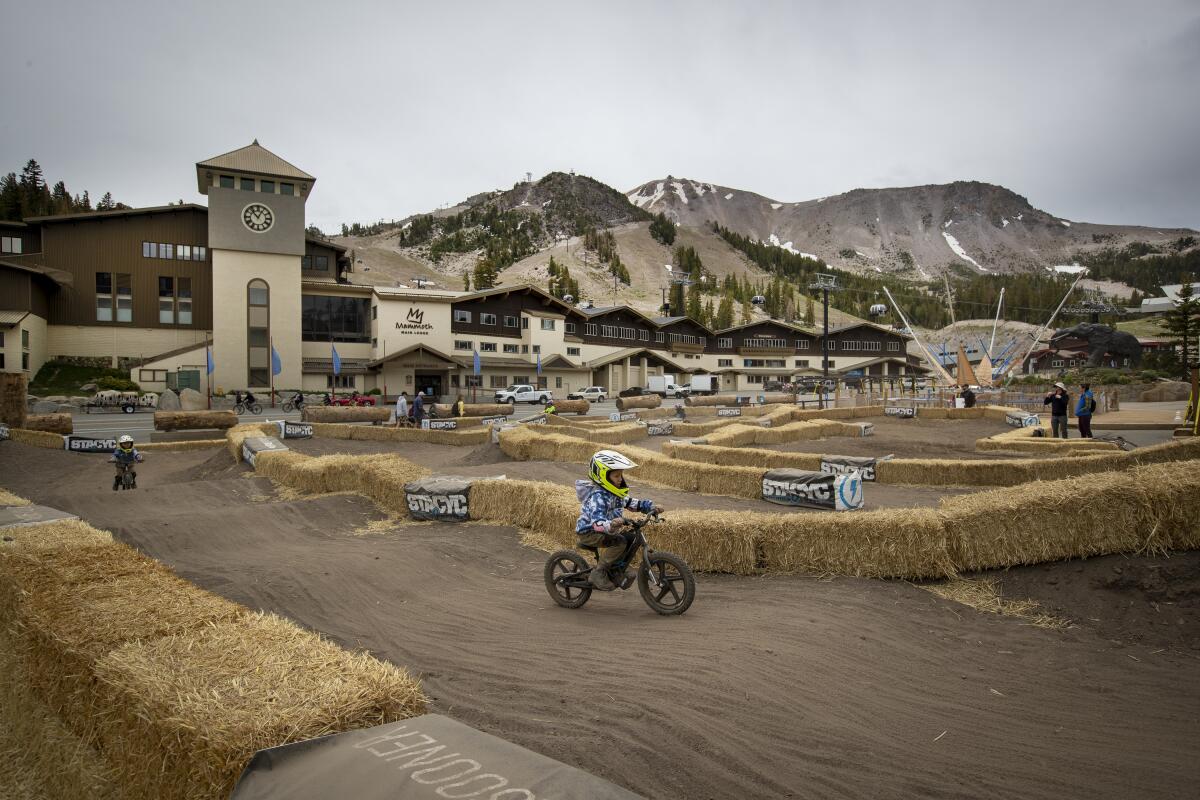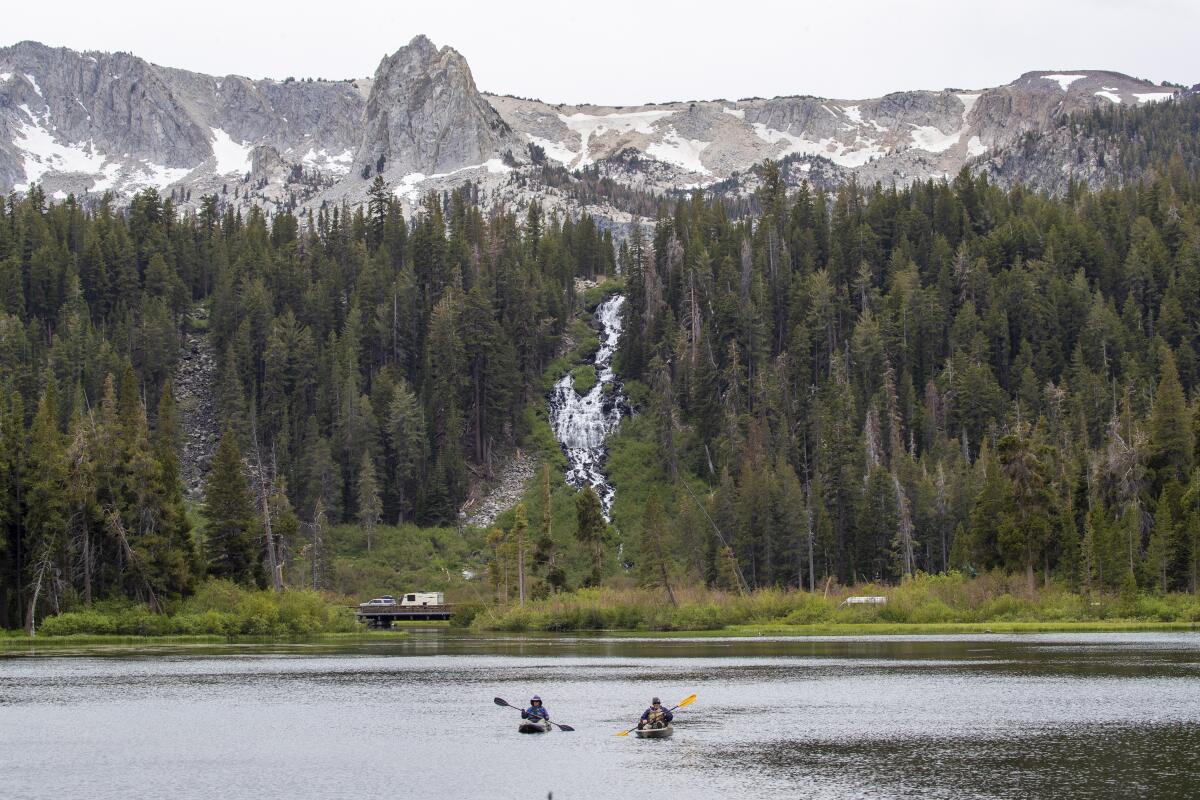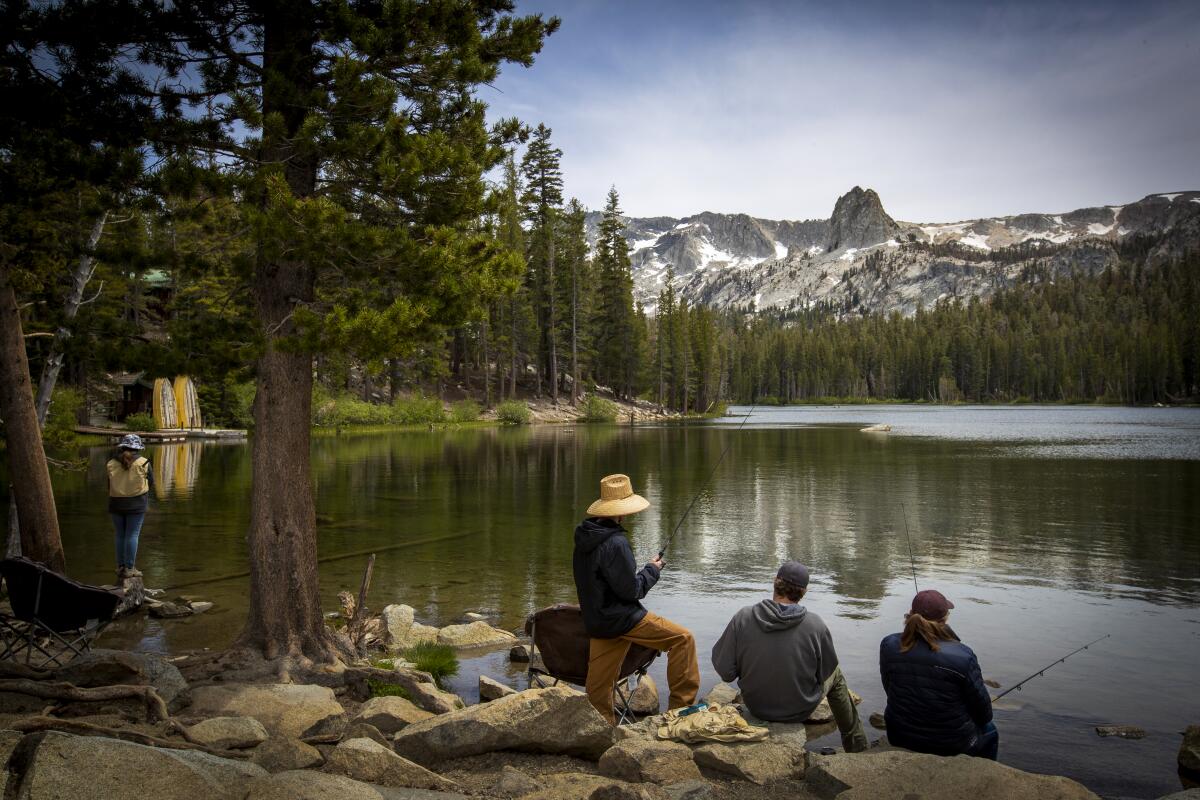Winter in Mammoth is great, but summer is when it shines

- Share via
Twin Falls was roaring and there was talk of trout near its base. Those were all the excuses Randy Mayer needed.
Mayer put on his Dodgers hat, gathered up his sons West and Van, hopped in a skiff on Upper Twin Lake and launched a little Mammoth Lakes family adventure.
“It’s the best up here in the summer,” said Mayer, who splits his time between Los Angeles and Mammoth. “Most people don’t know it. You can hike to a different lake every day.”
Winter is what made Mammoth famous, and it still makes the Mammoth Mountain resort a big chunk of its money, thanks to the hundreds of thousands of travelers who head that way from L.A. with snowboards and skis. But summer actually brings more visitors to this part of Mono County — hikers, anglers, birders, mountain bikers and multisport families like the Mayers.
The pandemic has underlined that fact. As this summer begins, thousands of Southern California families are arriving or returning here to play on the Sierra slopes, forests and lakes that surround the town of Mammoth Lakes (population: about 7,300) and the Mammoth Mountain resort next door. Though fishing was the area’s summer mainstay for decades (and remains an option now), many never get around to it.
Besides hotels and motels, the Mammoth area includes a large number of vacation rentals (mostly condos), along with thousands of nearby sites for RV and tent camping in warmer months.
To get there from Southern California, you’ll probably be driving up U.S. Route 395, whose small towns and mountain views make this a quintessential California road trip. It’s not a quick drive — about 310 miles from L.A. City Hall to Mammoth via 395 — but parts are spectacular.
Here are six summer adventure ideas within 50 miles of Mammoth Lakes.
Bike and hike Mammoth Mountain

Start with Mammoth Mountain, about five miles west of town on Minaret Road. Founder Dave McCoy (1915-2020) built it in the 1940s as a place for skiers only. Nowadays when the snow dwindles (skiing ended on June 5 this year), mountain bikers take over the chair lifts. About 80 miles of single-track trails cover the slopes of the park, following different routes than the ski runs. (Helmets, knee pads, elbow pads, gloves and eye protection are recommended.)
By the time I reached the mountain in late June, legions of cyclists, including many families, were zooming through the trees and down the dirt trails from Chair 11. Sightseers lined up for the Panorama Gondola, which runs to the mountain’s 11,053-foot summit (where the Eleven53 Cafe serves lunch). Two more chairlifts and the gondola are expected to open to bikers on July 1.
The resort Adventure Center (just across Minaret Road from the lodge) serves as a clearinghouse for booking activities, including (for kids) a neighboring ropes course, climbing wall, zip line and bungee trampoline. Up on the mountain, there are six via ferrata guided climbing routes (steel cables, iron rungs, suspended bridges) waiting for adventurers 12 and older.

Hiking happens on Mammoth Mountain too — including, if you’re up for it, a strenuous five-mile path to the summit.
Near the Adventure Center stands the Yodler, the Bavarian-themed eatery that has neighbored the lodge since 1959, offering aprés-ski drinks and snacks. I feared this would be a quantity-over-quality situation, especially when I saw the $2 beers on offer for Bike Park ticket holders. But my lunch there — Black Forest ham sandwich with salad for $17 — was tasty and ample. Looking for a more ambitious menu? Think about Toomey’s, which does breakfast, lunch and dinner; or the Lakefront Restaurant, a longtime dinner-only destination for fine dining.
Float the Lakes Basin

If you haven’t taken Lake Mary Road heading south out of town, you may not understand why the place is called Mammoth Lakes.
The first body of water you reach is Twin Lakes, where you’ll find a campground, a general store and the yurt containing Tamarack Bike & Paddle. The Tamarack Lodge and its three dozen cabins are also near water’s edge.
Upper Twin Lake, where I came across the Mayers launching their boat, is fed by Twin Falls (a.k.a. Mammoth Creek). And atop Twin Falls — where I spent a good spell clambering around on rocks, admiring the whitewater from various angles — you find Lake Mamie.

From there, the waterworks continue: Lake Mamie, Lake Mary, Horseshoe Lake and Lake George, with assorted campgrounds, marinas, general stores, lodges and trails nearby. The Lakes Basin Path, a 5.3-mile paved route that connects Twin Lakes, Lake Mamie and Horseshoe Lake, is a favorite route, open to hikers and bicyclists.
To reach the basin area from the village, or just explore the basin, find one parking place for the day, then take the Mammoth Lakes Basin Trolley, a free service that runs 9 a.m. to 6 p.m. daily, but only in summer. (There are entertainers aboard on weekends.)
Explore Devil’s Postpile National Monument

The basalt rock columns on basalt rock at Devil’s Postpile National Monument are only about 10 miles from Mammoth Mountain. The area around the formation makes a nice hike once you’ve taken the $15 shuttle bus into the Red’s Meadow area from Mammoth Lakes or Mammoth Mountain. Also, Rainbow Falls (101 feet high) is just 2.4 miles from the Devil’s Postpile rocks. With a hike of 3.4 miles you can do both, then continue to the Red’s Meadow Resort and catch the shuttle bus back to Mammoth.
Mellow out on June Lake
June Lake is about 20 miles from Mammoth and beloved for fishing, fall foliage and its sleepy setting (and in winter, a tiny, kid-friendly ski mountain). Even if you don’t have time to stop, the June Lake Loop (a.k.a. Highway 158, closed in winter) will take you past June, Gull and Silver lakes before rejoining 395. If you do have time, the Silver Lake Resort’s Silver Lake Cafe is open daily (7 a.m.-2 p.m.; three-egg omelettes), as is the general store (7 a.m.-7 p.m.). Also, there are two campgrounds, including Oh Ridge (its views may explain the name) on the eastern shore of the lake.
Roam Yosemite National Park’s high country
In summer months when it’s open, State Route 120 leads to great things. It runs from 395 west through the Tioga Pass, allowing drivers to head into Yosemite’s high country — a gorgeous territory that doesn’t see nearly the crowds that can clog Yosemite Valley. (In winter, snows close and bury the Tioga Pass.)
First, be sure you have an overnight reservation or day trip booking to enter the national park — that’s a requirement (to limit crowds) through Sept. 30. Then get on 120 westbound at Lee Vining (which overlooks Mono Lake) and you can reach the park’s sprawling, green Tuolumne Meadows (21 miles) in about half an hour. Tenaya Lake (picnicking, swimming, canoeing) is another seven miles west and panoramic Olmsted Point is two to three miles beyond that.
A few cautions: If you’re headed to Yosemite Valley from Lee Vining, that will take about two hours (75 miles on mountain roads). Also, the campgrounds of Tuolumne Meadows are closed until 2024 or 2025 for an infrastructure overhaul. And the road to Glacier Point (and its sweeping view of Half Dome and the valley) is closed throughout this year for repairs.
Eat, sleep and shop in Bishop

If you’re driving from Southern California to Mammoth, Yosemite’s high country or Lake Tahoe, chances are good you’ll stop in Bishop, either for a meal or a night’s sleep. To join a long history of hungry passers-through, step into Erick Schat’s Bakkery, long known for its breads, sweets and family-friendly vibe. You can’t miss the two-story Schat’s building at 763 N. Main Street (although now that the family empire also includes a roadhouse and wine cellar within a few blocks, you will find a lot of Schats around town).
For lunch or dinner, consider Holy Smoke Texas Style BBQ (772 N. Main St.), which has tender, tangy pork and brisket and tops the town’s Yelp ratings for eateries. For something more beer-centric, head to Mountain Rambler Brewery (186 S. Main).
The Creekside Inn (725 N. Main St.) has 87 rooms, 39 of which face the hotel’s clever landscaping along Bishop Creek (including several fire pits). Rooms are spacious and comfortable, walls are covered with brilliant Sierra images by the late Bishop-based photographer Galen Rowell, and the hotel’s overall design is always western, never kitschy.
If you have time to shop, one strong option is the Toggery (115 N. Main St., for hats, jeans, boots, blankets, Breyer horses and other accessories), which goes back to 1922. Another is Spellbinder Books (124 S. Main St. for a broad, thoughtful selection of books and gifts, including many volumes on local history).
By the way, one more 395 tip: It’s a long, straight route, with limits of 70 mph for much of the way. But if you fail to follow the 25- to 35-mph speed limits as you pass through Lone Pine, Independence, Big Pine and Bishop, there may well be a CHP officer ready to nab you for speeding.
But wait, there’s more
There’s no way to be comprehensive here. Still within 50 miles of Mammoth, the Sierra and Owens Valley offer up dozens more attractions and surprises. The eerie tufa towers and migratory birds of Mono Lake. The cabins, marina and fishing at the Convict Lake Resort (whose owner recently took over the nearby McGee Creek Lodge). The ghost town of Bodie. The painful history of Manzanar National Historic Site. The rustic steaming baths of Travertine Hot Springs near Bridgeport.
- Share via
Watch L.A. Times Today at 7 p.m. on Spectrum News 1 on Channel 1 or live stream on the Spectrum News App. Palos Verdes Peninsula and Orange County viewers can watch on Cox Systems on channel 99.
More to Read
Sign up for The Wild
We’ll help you find the best places to hike, bike and run, as well as the perfect silent spots for meditation and yoga.
You may occasionally receive promotional content from the Los Angeles Times.








